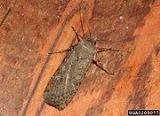
Army cutworm
Encyclopedia
The army cutworm is a species of moth
.
 Its caterpillars are pests of oat
Its caterpillars are pests of oat
(Avena sativa) and common wheat
(Triticum aestivum).
regions in late June and early July where they feed at night on the nectar of wildflowers. Army cutworms are one of the richest foods for predators, such as brown bear
s, in this ecosystem, where up to 72 per cent of the moth's body weight is fat, thus making it more calorie-rich than elk or deer.
Moth
A moth is an insect closely related to the butterfly, both being of the order Lepidoptera. Moths form the majority of this order; there are thought to be 150,000 to 250,000 different species of moth , with thousands of species yet to be described...
.

Oat
The common oat is a species of cereal grain grown for its seed, which is known by the same name . While oats are suitable for human consumption as oatmeal and rolled oats, one of the most common uses is as livestock feed...
(Avena sativa) and common wheat
Common wheat
Common wheat, Triticum aestivum, is a cultivated wheat species.-Nomenclature and taxonomy of the variety and its cultivars:-Evolution:...
(Triticum aestivum).
Location
Euxoa auxiliaris is commonly found in the Western section and prairies of the United States. They are known to travel to alpine climateAlpine climate
Alpine climate is the average weather for a region above the tree line. This climate is also referred to as mountain climate or highland climate....
regions in late June and early July where they feed at night on the nectar of wildflowers. Army cutworms are one of the richest foods for predators, such as brown bear
Brown Bear
The brown bear is a large bear distributed across much of northern Eurasia and North America. It can weigh from and its largest subspecies, the Kodiak Bear, rivals the polar bear as the largest member of the bear family and as the largest land-based predator.There are several recognized...
s, in this ecosystem, where up to 72 per cent of the moth's body weight is fat, thus making it more calorie-rich than elk or deer.

